- Blog: Read updated information on trafficking, abuse, trauma and treatment.
The reviews are written by the STOPP website staff, or by Guest Reviewers.
- Trump Department of Justice Funds Housing for Trafficking Survivors
Trump Department of Justice Funds Housing for Trafficking Survivors
Written by STOPP Website Staff (08/18/2020)
On 08/05/2020, Attorney General William Barr and Senior Advisor Ivanka Trump hosted a White House meeting of survivor advocates. At the meeting Attorney General Barr announced Justice Department Housing grants of $35 million to support housing for survivors of human trafficking. This is the largest federal investment of this kind. The funds will be shared by 73 organizations in 34 states. It will help thousands of survivors to get a start on a new life after they are rescued from Human Trafficking.
Attorney General Barr declared that the Justice Department will continue to pursue justice for survivors.
Ivanka Trump has from the beginning of the Trump Administration, supported President Trumps’s goal to end human trafficking, a seemingly impossible task. She spoke at this meeting about the nine pieces of legislation President Trump has passed to help survivors, and his plans to put funds “into the hands of those on the front lines.” She noted that just this year, $70 million has already been awarded to fund enhanced prosecutions, and $123 million for supporting state and local governments in this work.
The DOJ Housing grants will support rent, utilities, counseling services, vocational education, and job training. Housing support is the most prevalent need for human trafficking survivors. According to Advisor Trump, COVID-19 has heightened this need as survivors have sheltered in place with their traffickers, who are their abusers. Since COVID quarantine, in the United States, calls for help to the Human Trafficking Hotline have increased by 40%. Around the world, 25 million people are living in modern day slavery.
If you wish to watch the entire meeting, with information by two other White House staffers, and representatives of three of the organizations who are receiving grant monies, go to this link:
https://www.youtube.com/watch?v=BMHM-7ygUU8&feature=youtu.be
- Barcelona Trafficking Network is Dismantled
Written by STOPP Website Staff (08/08/2020)
In mid-July, police arrested 12 human traffickers and identified almost 1,000 trafficking survivors in Spain. The Mossos d’Esquadra (the police force of the region of Catalonia, headquartered in Barcelona, in northeastern Spain) dismantled a major international human trafficking ring in Barcelona. Most of the 12 arrested individuals were of Sub-Saharan and Moroccan nationality. They were smuggling Africans into Europe and exploiting them for labor.
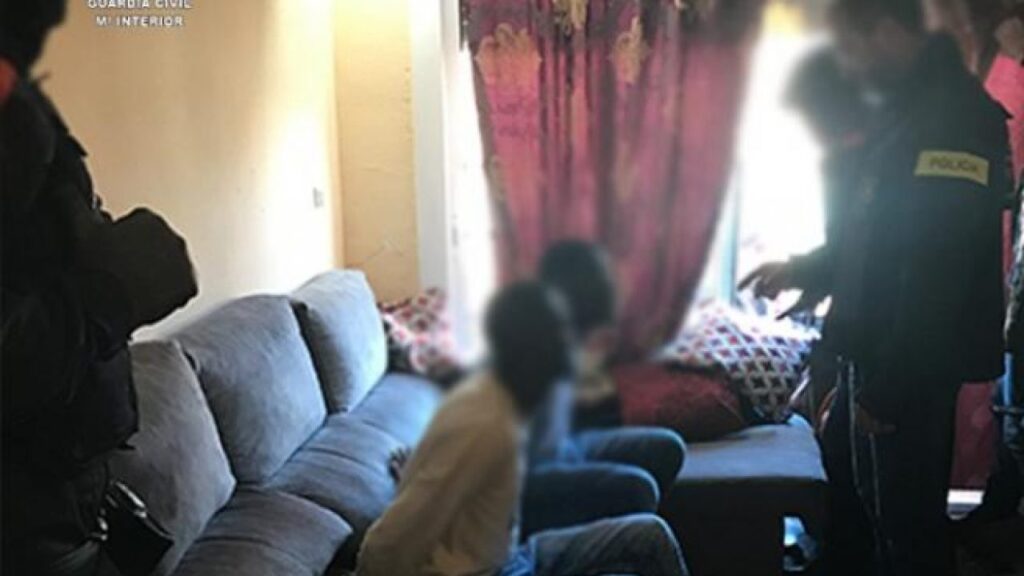
Twelve Arrested in Trafficking Network euroweeklynews.com
Police investigated in other countries as well to break up this international ring. There were three searches in Portugal, two in Germany, and one in the Netherlands. Almost 1,000 victims were found including mothers, pregnant women, and children who were recruited to work. Hundreds of thousands of dollars were also discovered, along with two kilos of marijuana.
This investigative operation has been ongoing since 2018 when police identified a criminal gang that was transporting undocumented migrants into France. The victims were transferred from Spain to France, Belgium, and Germany. The traffickers charged the victims at least 500 euros ($566 U.S.) to be transported for the labor, and then often abandoned women and minors in various countries if they, including children, could not pay the full amount that the traffickers said that the victims owed them. This two year operation located almost 1,000 victims.
- Arrest of Ghislaine Maxwell
Written by STOPP Website Staff (07/14/2020)
Ghislaine Maxwell (DOB: 12/25/1961) is a British socialite best known for her association with convicted sex offender Jeffrey Epstein. Maxwell was arrested by the FBI on July 2, 2020 on charges that she lured and groomed girls as young as 14 years old for illegal sexual activity. Federal prosecutors claimed that she procured girls for Epstein and that she also participated in the sexual abuse of those girls.

Jeffrey Epstein and Ghislaine Maxwell
Jeffrey Epstein had called Maxwell his “main girlfriend” and it is said by friends of hers that she had access to documents and videos belonging to Epstein. After Epstein’s death while he was imprisoned in New York City last year, authorities vowed to pursue his associates and Maxwell took a low profile. (For more information on Jeffrey Epstein’s’ death in prison, see our blog below on 09/12/2019.)
Maxwell had not been seen in public since August of 2019. She was found and arrested at an isolated luxury home in New Hampshire woods on July 2, 2020. More than 20 armed agents and police are said to have participated in the arrest before 6:30 am. Maxwell was transferred from New Hampshire, and then from the Metropolitan Detention Center of New York, and is currently being held at a federal detention center in Brooklyn. Maxwell, 58, faces six charges including conspiracy to entice minors to travel to engage in sexual acts, enticement of a minor to travel to engage in illegal sexual acts, conspiracy to transport minors with intent to engage in criminal sexual activity, transportation of a minor with intent to engage in criminal sexual activity, and perjury, from 1994 through 1997. If convicted of these charges, Maxwell could face up to 35 years in prison. She has repeatedly denied any wrongdoing.
FBI Briefing on the Arrest of Ghislaine Maxwell by Audrey Strauss, Acting United States Attorney for the Southern District of New York, and William Sweeney, Assistant Director in Charge of the FBI Field Office.
Maxwell has described herself as managing Epstein’s many properties across the United States and she has denied any knowledge of Epstein’s illegal and abusive activities. However, she has been named by many of Epstein’s victims as procuring, training and trafficking underage girls for Epstein, and of abusing the young women, as well. There are photos of her aboard Epstein’s private plane nicknamed the Lolita Express, which ferried politicians and Hollywood elite to Epstein’s private island, Little St. James, where it is said minor girls were kept and trafficked to Epstein’s powerful associates. Maxwell has denied the allegations of procurement and abuse, but she lost a defamation lawsuit brought against her by one of Epstein’s victims whom she had accused of lying about her.
Steps are being taken to prevent the possibility of Maxwell’s suicide, including the use of “paper clothing” a cellmate, and overseeing her cell.
- Cell Phone Jammers – A True Story
Written by STOPP Website Staff (06/10/2020)
Katie’s Frightening Drive
This is a true story and was told to me by a friend of Katie’s family.
Katie (her name has been changed for her privacy) was driving to her family’s home in Pennsylvania from her college in New Jersey for a weekend visit. She was driving on the highway around dusk when she noticed a dark sedan driving behind her. She watched this car for quite some time. As she sped up, slowed down, and changed lanes, Katie realized that the car was following her closely. Feeling uneasy, Katie picked up her cell phone and dialed her mother’s phone number to ask for advice. As soon as her mother answered the phone, the line went dead. She tried her mother’s phone several times and each time, the call dropped. She then dialed her father’s phone number and the same thing happened. The dark sedan continued to follow her. Now frightened, and feeling isolated and alone, Katie dialed 911 and immediately the dark sedan slowed and disappeared back into the traffic behind her.
Katie is Introduced to a Phone Jammer
Katie explained her concerns to the 911 dispatcher who told her to continue driving until she was pulled over by a state trooper. After she and the state trooper pulled off on the side of the road, he listened to her story. He explained to her that she had been the victim of a phone jammer. Like most of us, Katie had never heard of a phone jammer.
The trooper explained that jammers are easy to use devices that can be portable. He explained to her that cell phone users do not even know that their phones are being jammed. The phone will indicate that there is no service or no signal, or calls will be dropped. The jammer interrupts the phone’s ability to establish a link with the nearest cell phone tower.
The trooper explained to Katie that in many but not all jurisdictions, jammers are unable to block emergency calls such as her call to 911. The trooper told Katie that it is quite possible that this person would have tried to abduct her if she had gotten off the highway for gas or something to eat, and she would have been unable to call for help. He told her that if this ever happened again, that she should immediately dial 911 and explain that her phone was being jammed. Devices called blockers or jammers block all cell phones in the immediate area, but jammers often cannot block emergency calls. The trooper told Katie that the person following her who was using the jammer was able to see on the jammer when she dialed 911 and immediately slowed his car and disappeared into traffic so that he could not be identified.
How Do Jammers Work?
Jammers block phone calls, texts messages, GPS systems and Wi-Fi networks. The range of a jammer depends upon the power and size of the particular jammer, and upon the surrounding environment and landscape. For example, hills or buildings or walls could block the signal of the jammer.
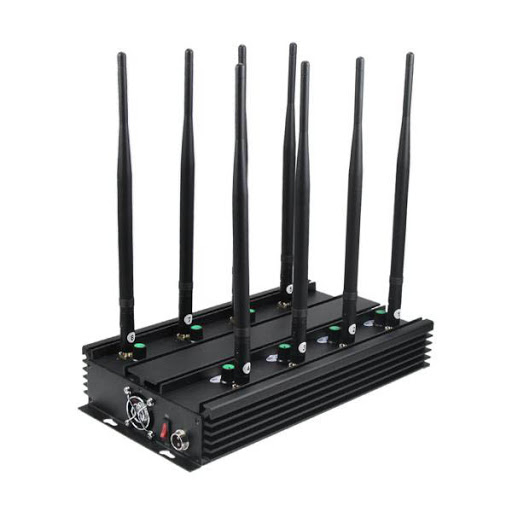
Eight Channel Desktop Cell Phone Jammer
Some jammers, like the one pictured above, are desk-top size, and are more powerful. A portable jammer can be as small as a cellphone. Low-powered jammers will block calls only to a range of about 30 feet, which is why Katie was being followed so closely. And even though Katie was the driver being targeted, every cell phone within thirty feet of the jammer would have been blocked as that dark sedan drove by.

Portable Cell Phone Jammer
Jammers, or blockers, were originally developed for use by the military and law enforcement to combat threats like cell phone triggered explosives and hostage situations. They work by sending signals stronger than the nearest tower’s signal on the same radio frequencies as mobile phones, disrupting the transmission between the phone and the tower, and disabling all mobile phones within the range of the jammer. This prevents the cell phones from sending or receiving signals.
Jammers and the Law
Blocking cell phone service is against the law in the United States, United Kingdom, Australia, and other countries. In the United States, cellphone jamming is covered under the Communications Act of 1934 which prohibits people from “willfully or maliciously interfering with the radio communications of any station licensed or authorized” to operate. Even the “manufacture, importation, sale or offer for sale including advertising of devices designed to block or jam wireless transmissions is prohibited.” Jamming is considered property theft because a private company purchased the rights to the radio spectrum and jamming that spectrum is akin to stealing the property that the company purchased. It is also considered a safety hazard because jamming blocks all calls in the area.
Under laws in the United States, fines for a first offense can range as high as $11,000 for each violation, or imprisonment for up to one year, and the device may also be seized by the government.
In most countries it is illegal for private citizens to jam any cellphone transmissions. Some countries, however, are allowing businesses and government organizations to install large jammers in areas where cell phone use is seen as a public nuisance, such as in movie theaters and concert halls. India installed jammers in parliament and in some prisons. Universities in Italy have adapted the technology to prevent cheating because students were taking photos of tests with their camera phones and sending them to classmates.
Fortunately, Katie dialed 911 when she became frightened and that emergency call to 911 was not blocked. Be like Katie. Be aware of your surroundings. If you think that you are in danger, dial 911. And if you think that your calls are being blocked by a jammer, let the 911 dispatcher know that. Please pass this information on to your children and your friends. Stay safe.
- Thorn’s Response to COVID-19
Written by STOPP Website Staff (04/30/2020)
Thorn is a nonprofit organization that was founded in 2012 by actors Ashton Kutcher and Demi Moore
after they watched a documentary that highlighted what was happening to children in Cambodia. They
soon learned that sex trafficking of children was happening here in the United States as well. Thorn’s
focus has been on innovation of technological means to ending online child sexual abuse.Thorn’s CEO, Julie Cordua, just released a timely statement regarding what Thorn is learning about the
impact of COVID-19 on worldwide sex trafficking and on our efforts to combat it. The following
information is pertinent to all who work in the field and is taken directly from Ms. Cordua’a letter.What Thorn is Learning
Thorn has worked among law enforcement, technological industry and NGOs for 8 years and so Thorn is
in a unique position to recognize trends across multiple child protection participants. Here is what
Thorn is seeing.COVID-19 has aggravated an already stressed Child Sexual Abuse Material (CSAM) reporting pipeline.
Detecting and removing Child Sexual Abuse Materials from the web relies on:- Tech companies that detect abuse content on their platforms, and on moderators who triage
and report them to the National Center for Missing and Exploited Children (NCMRC). Given
social distancing due to the pandemic, many content moderators are furloughed or are working
from home, where they are unable to review abuse content, meaning more unfiltered reports
are passing down the pipeline. - Demand for child sex trafficking is holding steady and may be taking new forms. What Thorn
has noticed on online escort sites – where children are often purchased for sex – is a 60%
reduction in massage parlor ads, with most of them having been closed by local and state
governments, but minimal sustained decrease in other ads for sex. Thorn has also heard of
vulnerable kids using technology, such as live streaming, for survival income. - Thorn has also seen an increase in online interest in search terms related to child sexual
exploitation. For years, Thorn has run a search deterrence program that intercepts people
searching for CSAM on the web and directs them to help resources. Since March 1, 2020, Thorn
has seen a 19% increase in deterrence keyword traffic. They cannot yet determine whether this
is due to offenders or other researchers, but they are increasing their presence to deliver
interventions. - Thorn is trying to hypothesize what the “new normal” will be. With more children and adults
online during this period of social distancing, they are watching closely for a potential increase
in online grooming and sexual exploitation. They are expecting that these already increasing
threats will continue to grow. Live-streaming abuse is also on the rise.
What is Thorn’s Response?
Thorn states that they are responding to immediate needs by prioritizing and fast tracking their work in
four main areas.- Thorn is improving automated content moderation. They are using technology to
prioritize the most urgent cases and are training more moderators and AI to identify and
report CSAM. Not only will these tools save lives now, but they will permanently improve
the reporting systems for the future. - Thorn is increasing the efficiency of trafficking investigations through their law
enforcement tools. Thorn’s tools have already reduced investigative time by 60% and they
are working to improve their effectiveness. - Thorn is continuing to deploy its search deterrence program and they are seeing an
increase in individuals connecting to the help resources that they provide. Thorn is also
working to get resources in front of increasing numbers of children at home, who may be
more vulnerable or isolated from their usual support networks. - Thorn is innovating in important areas like live-streaming and grooming.
Also, see our blog that is listed on 12/20/2017 below to watch Ashton Kutcher describe to Congress
Thorn’s technology that is helping law enforcement to identify and locate children being trafficked for
sex on the web.Thorn was founded to keep children safer online. You can follow Thorn’s work as they share updates,
resources and tools. On their website, you can register your email address.For General Inquiries: wearethorn.org
- Tech companies that detect abuse content on their platforms, and on moderators who triage
- Jeffrey Epstein Died in Jail
Written by STOPP Website Staff (12/09/2019)
Jeffrey Epstein (DOB 01/20/1953 was born in Brooklyn, New York. He died (08/10/2019) while incarcerated at the Metropolitan Correctional Center, New York, New York. Epstein was jailed awaiting trial on charges of sex trafficking and conspiracy to commit sex trafficking.

Jeffrey Epstein in 1984. Rick Friedman, Corbis News, Getty Images
Epstein was reported to be a billionaire who had worked as a financier. Two days before his death however, he had signed a will which indicated that he was worth less than $600,000,000. He had a high-profile social circle and associated with Bill and Hillary Clinton, Prince Andrew, Hollywood stars, and Ghislaine Maxwell.
He was a convicted sex offender who in 2006 had served 13 months in a Palm Beach County jail, with work release which allowed him to work at his office six days per week. He registered as a sex offender.
At the time of his 2019 arrest, police indicated that he “exploited and abused dozens of minor girls at his homes in Manhattan, New York, and Palm Beach, Florida, among other locations.” Some of the girls were as young as 14 years old. The indictment also indicated that “in order to maintain and increase his supply of victims, Epstein also paid certain of his victims to recruit additional girls to be similarly abused.”
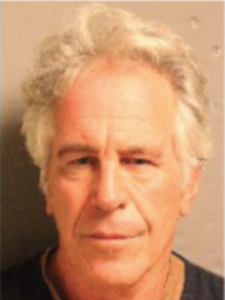
Mugshot taken July 8, 2019.
He was arrested in July 2019 and was denied bail. On July 8, 2019, federal prosecutors charged him with one count of sex trafficking of a minor and one count of conspiracy to commit sex trafficking. Epstein pleaded not guilty on both charges. On July 24, he was reportedly found injured in his cell. Early in the morning on August 10, he was found unresponsive in his cell. Prison guards performed CPR and he was transported in cardiac arrest by EMS to the New York Downtown Hospital where he was pronounced dead. His death was officially ruled a suicide by hanging, by the New York City Chief Medical Examiner, Dr. Barbara Sampson. His death was being investigated by the FBI and Department of Justice.
The declaration of Epstein’s attorneys that he had not been despondent as he was awaiting a bail hearing, his brother Mark’s belief that Epstein did not suicide, and several irregularities at the jail has led to the belief that perhaps he did not commit suicide. He had been reported to be on a suicide watch and so would have had a cellmate, but his cellmate had been removed from his cell before his death. Cameras outside his cell malfunctioned the night of his death. Guards were supposed to check on him every 30 minutes but two prison guards stated that they had both fallen asleep and so they were not aware of what might have happened in his cell. They have also been accused of falsifying records. The theory has been presented that wealthy and powerful associates of Epstein had arranged his death to keep secret their involvement in sexual trafficking and abuse of minors. Some are calling this a conspiracy theory.
Due to his death, the charges against him have been dropped. His victims are left without the satisfaction of a conviction, but several are suing his estate.
- Hue Jackson’s Human Trafficking Survivors’ Residence
Written by STOPP Website Staff (08/14/2019)
Hue Jackson is the head coach of the NFL’s Cleveland Browns. Jackson and his wife Michelle founded the Hue Jackson Foundation with the intention of serving survivors of human trafficking, and educating people about trafficking. In July 2018, Coach Jackson had a ribbon-cutting ceremony for the Hue Jackson Foundation Survivors of Human Trafficking Residence in Cleveland, Ohio.
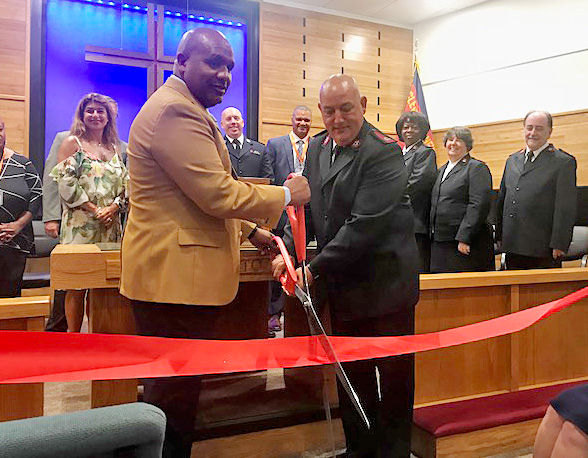
This 12 bed, 4500 square foot facility is part of the Salvation Army of Greater Cleveland’s Harbor Light Complex, which had recently built six beds for survivors. The Hue Jackson Foundation donated $250,000 toward the renovation of the third floor to serve survivors in Northeastern Ohio.
At the ribbon-cutting ceremony, Coach Jackson spoke at the Harbor Light Complex Chapel. He stated that regarding human trafficking, “lives are forever changed. For those lucky enough to escape their trafficker and the life of indentured servitude, those who survive, they live with the horrors and the memories that they can never forget. They close their eyes at night, still wondering how they got to where they are today. They fear where they will be tomorrow. They are stuck in a cycle of anxiety, uncertainty, and trauma that no person should ever have to endure.“
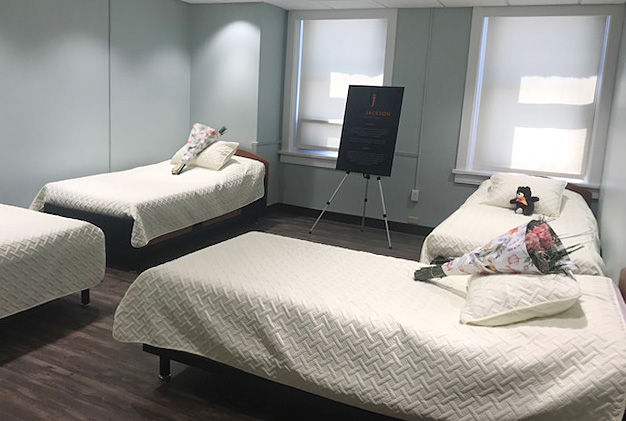
Coach Jackson noted that “we cannot ever prepare our children for the monsters that present themselves as friends, as family members, co-workers, or simply the neighbors next door …. What do you say to your child, to your sister, to your friend or a stranger who asks you, ‘Why did this happen to me? Why didn’t you prepare me for this? What did you do to protect me?’ Through the Hue Jackson Foundation, we will educate our community, our neighborhoods and our children about the warning signs and dangers of human trafficking. We will tell them and show them how things like social media and the risky behaviors can lure even the most innocent among us. We will help the victims by giving them resources that they need to become survivors. We will show them that there is hope.”
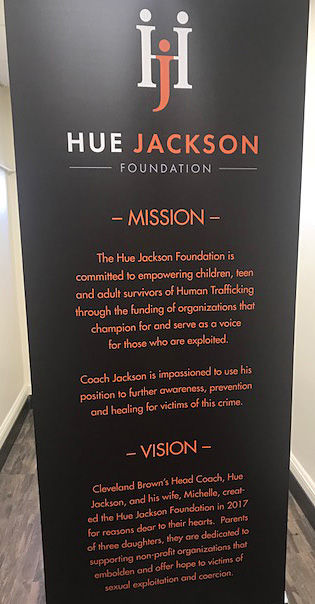
Coach Jackson will solicit more help from the NFL, “to ask every NFL team to stand beside us as we stand for those who cannot stand alone.” Jackson’s survivors’ residence, which is staffed by the Salvation Army, will provide counseling, medical treatment, addiction services and more.
To read the complete article about the residence, go to Cleveland.com
- Journal Article on a Comprehensive Treatment Model for Sex-Trafficked Women
Written by STOPP Website Staff (07/14/2019)
Munsey, Susan, Miller, Heather E. Rugg, Terence (2018). GenerateHope: a comprehensive treatment model for sex-trafficked women. Journal of Evidence-Informed Social Work 15:4, 420-431. doi: 10.1080/23761407.2018.1467809
GenerateHope is a nonprofit organization based in San Diego that provides comprehensive services to adult female survivors. This article looks at the GenerateHope residential program and provides early outcome results for residents living at the program for 6 to 12 months.
GenerateHope’s program includes a 30-hour per week schedule that includes academics, trauma-related psychotherapy and supplemental therapies. For this study, GenerateHope used three assessments to assess improvements in well-being, including the Hamilton Depression Rating Scale, Post-Traumatic Stress Disorder Checklist – Civilian Version, and Rosenberg Self-Esteem Scale. Results of the three assessments showed dramatic improvements: a reduction of depression and PTSD symptoms, and self-esteem dramatically improved. Results indicated that this program is transferable to other settings. The paper also describes challenges in implementing the program.
- Continent-Wide Human Trafficking Hotlines
Written by Stopp Website Staff (06/14/2019)
Polaris has administered a Human Trafficking Hotline in the United States for several years. Polaris has announced that they have been working with the Canada Centre to End Human Trafficking, who has been awarded the contract to build and run Canada’s first national human trafficking hotline. Polaris has been working with the Centre to build out the plan for the hotline, which is modelled on the Polaris-operated U.S. National Human Trafficking Hotline.
Polaris has for the past three years also been working with Consejo Ciudadano, which runs the national human trafficking hotline in Mexico. Given Canada’s building of a national hotline, North America is now on its way to having a continent-wide response for victims and survivors of human trafficking.
- Opportunity to ATTEND or PRESENT at the 2019 Global Conference on Human Trafficking and Trauma!Written by STOPP Website Staff (05/20/2019)
Join us at the Global Conference on Human Trafficking and Trauma!

WHAT: Opportunity to develop and explore human trafficking – survivor informed and mutually informed research, policy, and services.
WHERE: University of Toronto, Mississauga Campus
WHEN: June 24 – 25, 2019
Call for Abstracts – Global Conference on Human Trafficking and Trauma – Click Here
For more information and to register, visit us at: https://fspeel.org/peel-institute/conferences/
Don’t forget to check out the: Official Press Release
Brought to you by Family Services of Peel – Peel Institute on Violence Prevention, HEAL Trafficking, and the Women and Gender Studies Program at the University of Toronto Mississauga.
- Empowering Online Safety Guide for Women: Online Dating, Meetup, Intimate Partner Violence, and SOS AppsWritten by STOPP Website Staff (04/15/2019)
This is the third article in a series of three blogs taken from vpnmentor.com, with their permission, and with their encouragement to share this information. Please feel free to use the link below to examine the complete Empowering Online Safety Guide for Women. You will find it to be a wonderful collection of very clear and instructive information having to do with online safety for women.
Because 76% of girls who are trafficked begin their contact online, it is important that parents share information with their children in an appropriate way. This Safety Guide can help you to do that.
Online Dating and Sexual Harassment
Online dating is where women are most vulnerable to cyber-sexual harassment.
Catfishing is when someone misrepresents themselves online, using fake photos and profiles. Also, a woman can unknowingly become the accomplice of a catfisher when her profile is captured by a catfisher and is used on someone else’s dating profile.
Unfortunately, one cannot date online and also guarantee that you will never be a victim. Protect yourself on Dating Sites:
- Do a Background Check: search the person on Google, Facebook, and other dating apps. Look for inconsistencies in their pictures and profile descriptions. If you find any, report the profile to your app.
- Get to Know the Person on the App: Chat on the app before moving the conversation to another platform. Get to know the person before divulging personal information. When you do move to another platform, be aware of what they can see there, e.g., photos, status updates, contacts. See the link below to learn which platforms show what info. If you do want to meet in person, be sure to meet in a public place, and let a friend know where you will be.
- Keep Your Social Media Accounts and Pictures Private.
Meetup.com
Meetup allows users to create and join events and activities based on themes and activities that interest them. Popular categories include health and fitness, food, film, pets, etc. It is a way to meet new people and make friends. But be careful:
- Don’t include too much personal information on your profile. Your profile will be available to anyone who is on the internet. Do not give any identifying info regarding your home or work locations. If you are looking for family meetups or playdates, do not give info about your children, where they go to school, their names, etc.
- Get to know People IRL before Communicating One-on-One: You can use the Meetup email system, so that your emails go through the organization. You can choose to block messages from users and only receive notices from event organizers. You can also choose whether you want your groups or interests listed on your profile.
- Let a Friend Know Where You Are Going: Tell a friend where you will be, and when you expect to be home. If the gathering involves drinks, never leave yours unattended.
Preventing Intimate Partner Violence
Intimate Partner Violence (IPV) affects nearly one third of American women. Technology can be used by victims to collect evidence against abusers, but abusers can use technology to control their victims. While many perpetrators use technology designed specifically for surveillance, it is more common to repurpose other types of apps to reach the same goals. These may include find my phone apps, and family tracking and child monitoring apps.
Many of these apps allow abusers to track a victim’s location, read her messages by forwarding them to another device, and even watch and listen to her remotely through her phone’s microphone and camera. These apps can usually be configured so that the app icon is hidden, making it nearly impossible for the victim to detect it on her phone. Even spyware has been largely ineffective at detecting these apps.
Ways to Keep a Partner from Surveilling You
- Keep your Phone on You at All Times. Almost all of the apps require that the abuser physically have access to the victim’s phone at least once.
- Be Cautious Using Any Phone That You Did Not Obtain Yourself. Abusers who control often control the money, too, and so end up being the one who purchases the phone. They can then pre-install dual purpose apps or purchase rooted phones with off-store surveillance apps.
- Password Protect Your Phone and Don’t Share Your Password with Anyone. If you suspect you partner is accessing your phone, change your password. Make it long and complex and do not use elements your partner might guess, such as your birthday or a pet’s name. Do not be coerced into revealing you password or allowing these apps to be installed on your phone.
If you are a victim of IPV, there are resources to help you to get out of your abusive situation. In addition to local organizations that you may find in your area, here are a few national organizations that can help:
- National Network to End Domestic Violence: https://nnedv.org/
- The National Domestic Violence Hotline: 1-800-799-7233
http://www.thehotline.org/resources/ - Family and Youth Services Bureau: https://acf.hhs.gov/fysb/resource/help-fv
SOS Apps
It’s a great idea to have an emergency app on your phone, just in case. These apps let you notify friends, family, or authorities when you’re feeling unsafe. Some phones have these features built in. If your phone does not, check out these apps, all of which are available for both Android and iOS:
- ICE, which stands for In Case of Emergency. ICE allows you to send a message and your GPS location to selected contacts when you want friends and family to keep tabs on your whereabouts. (https://play.google.com/store/apps/details?id=com.lafache.sylvain.ice_andrid&hl=en)
- React Mobile does the same thing as ICE, but also has an SOS Help Me button that notifies your pre-chosen contacts via email and text. If you choose, it will also post a message to Facebook and Twitter. It also automatically contacts local emergency services. (https://itunes.apple.com/us/app/react-mobile-safety-app/id522851588?mt=8)
- Siren GPS won’t contact friends and family, but with the push of a button, it will alert emergency services and provide them with your location. You can also set up a personal profile with relevant information that is passed on to the authorities in case of an emergency. This can include medical conditions and emergency contact info. The app gives the option of calling the fire department, an ambulance, or police.
(https://www.sirengps.com/)
In addition to the above apps, you can also show certain information on your lock screen to be used in case of a situation in which you are unable to give information about yourself to emergency services. For example, you can write something like: “In case of emergency, call (Name of a contact)” and include their phone number. Or, if you have a specific medical issue, like a severe allergy or epilepsy, you can include that info, also. How to set a lock screen message will vary depending upon which model phone you have.
Conclusion
Technology and the internet play a big part in our lives. As women, we are often targeted, but that does not mean that we should necessarily disengage. We hope that this guide empowers you to protect and defend yourself online and in person.
If you found any part of this guide helpful, please share it with others.
Also, please follow the link below to see the complete Guide with additional information.
https://www.vpnmentor.com/blog/the-empowering-internet-safety-guide-for-women/
Many thanks to vpnmentor for making this Guide available, and for encouraging us to post this info for women.
- Building Recovery Conference on April 26, 2019
Written by STOPP Website Staff (04/04/2019)
There is an upcoming conference in Richmond, Virginia on April 26, 2019.
“Building Recovery: Starting a Comprehensive Residential Program for Survivors of Human Trafficking” is a one-day conference sponsored by Safe Harbor.
Safe Harbor is the first agency in the Richmond area to provide comprehensive services for survivors of sex trafficking. Their staff will share their expertise along with other experts. The keynote speaker will be Bonnie Martin, a recognized expert in trauma informed programs who has worked with thousands of victims of violence and human trafficking.
Safe Harbor has an application in process with the Virginia Chapter of NASW for continuing education credits for this conference.
Breakfast and lunch will be provided, courtesy of Capital One.
If you have questions, contact Elena Brooks-Perkins, Education and Outreach Manager, at elena@safeharborshelter.com
- The American Psychiatric Association Position Statement on Human TraffickingWritten by STOPP Website Staff (03/15/2019)
The American Psychiatric Association (APA), which is the author of the Diagnostic and Statistical Manual of Mental Disorders (DSM), is an authority and resource at the center of mental health in the United States. There is no diagnosis in the DSM for human trafficking per se, but it is notable that the APA in November 2018 published a Position Paper on Human Trafficking. It is important that the scourge of human trafficking is now recognized and acknowledged by the APA.
Following is the official release from the APA.
http://stopptrafficking.com/wp-content/uploads/2019/03/position-statement.pdf
- The Empowering Internet Safety Guide for Women, Part 2Written by STOPP Website Staff (02/15/2019)
Harassment at Work
According to one study, one in three women ages 18-34 has been sexually harassed at work. 25% of those women were harassed online, but 71% did not report it.
If you are in a work situation and are being made uncomfortable by sexual harassment, you should begin recording the incidents. Often larger cases are built on a record of small indictments, which must be documented properly in order to be used as evidence. If you are unsure whether an encounter is harassment, record it because the incidents may worsen as time goes on.
Then, report your situation. Many companies have policies in place as to how harassment is handled, and you should follow the company’s directions. If you feel that the company has not followed through, you can seek outside legal counsel.
LinkedIn
Because LinkedIn is a networking site, some people treat it as a dating site and women are harassed. Be aware that posting your resume reveals your email address and phone number on the header. Delete it from the version you post.
Protect yourself:
- Before accepting a LinkedIn connection, check to see if you have connections in common, or whether the person works in your industry.
- If you decide to block an unsolicited message, click on the 3 dots on the top right and then click Report this conversation.
- You can block that person from contacting you or viewing your profile: go to the person’s profile, click More>Report/Block and follow the directions.
- If you upload your resume, delete your phone number, home address, and other contact information. If someone needs to contact you, they can do it through LinkedIn.
Ridesharing
Uber allows you to share your ride online with 5 trusted contacts, so your friends can follow your progress during your trip, and see that you arrive safely at your destination.
Lyft has their Send ETA feature, which allows you to send your route and Estimated Time of Arrival to a friend. For both Uber and Lyft, these features include the car’s make and model, license plate number and a photo of the driver.
Uber also is working on a 911 feature that will allow you to contact 911 and will automatically provide your location in real time to the police.
Stay safe:
- Make sure that you are getting into the right car: check license plate, make and model, and the driver’s name and photo.
- Do not let the driver know that your pick-up point or your destination is your home or employer.
- Check the driver’s reviews.
- Track your route while in the car. Make sure the driver is going in the appropriate route.
- If something doesn’t feel right, have the driver pull over and get out. Don’t worry about awkwardness or embarrassment.
If Your Phone is Lost
Our phones contain a lot of personal information. If your phone is lost or stolen, there are things that you can do to safeguard the contents of your phone.
- Password protect your phone.
- Locate your phone. If you have GPS on your phone, you can set it up to track the phone’s location. Go the link to find directions for Android or iphone.
- Erase your data. If you are sure that you are not getting your phone back, you can use apps to remotely erase all the data on your phone. Go the link below for directions on how to do so.
- Change the passwords for all your apps.
Please follow the link below for more detailed information. Our thanks to vpn.mentor for making this valuable information available to women.
www.vpnmentor.com/blog/the-empowering-internet-safety-guide-for-women/
- The Empowering Internet Safety Guide for Women, Part 1Written by STOPP Website Staff (02/05/2019)
Many victims of sexual trafficking are first approached online, because online, groomers can remain faceless and anonymous. This is true for even preteen children. In addition, many adult women are harassed online.
According to a 2017 study by the Pew Research Center, most online abuse occurs on social media, and women are more than twice as likely as men to experience sexual harassment. More than half the women ages 18-29 report having been sent sexually explicit images without their consent. Many women are intimidated into withdrawing into silenced disengagement.
The Empowering Internet Safety Guide for Women was written to empower women to navigate the internet fearlessly and safely. This information should be shared with your sons and daughters who are online, as well.
This information will be shared in our next three blogs, in three parts. On the blogs, we are offering only an outline of the information. Please go to the link below to read more detailed information.
Today’s blog will cover Harassment on Social Media. Most online harassment occurs on social media. Following are the most popular social media platforms:
Twitter
Twitter is one of the most notorious media platforms for online harassment. Twitter’s response to online harassment has had a poor reputation, even after improving their response to reports of harassment. Here are 5 ways to protect yourself on Twitter:
- Use multiple profiles. Include a personal and a professional one.
- Report and block abusers. See the link as to how to report and block.
- Don’t Geotag. To geotag is to include the location from which your post was sent.
Don’t use the geotag option, and do not include in the text where you are when posting.
Do not open yourself to doxing or stalking, or worse. - Prevent Doxing. Doxing is the most extreme form of online harassment. It involves publishing online a person’s contact and personal information, including address, workplace, banking info or family information, as a call to others to harass the person.
This can result in rape and murder threats.
To prevent Doxing:- Google yourself and see what information is already online about you. Remove what you can.
- Subscribe to a service that will delete you from data broker sites.
- Check that your email account hasn’t been involved in a data breach. Use the tool: https://haveibeenpwned.com/
- Use a VPN: a virtual private network can encrypt your online activity to protect you from hackers.
- Prevent Hackers from taking over your Twitter account:
- Create a strong password.
- Enable login verification, entering a code that Twitter sends to you.
- Be wary of any third party app that requires access to your account.
- Watch out for shortened URLs and don’t click on links you see posted on other people’s tweets.
Facebook
Every day, women are solicited by strangers amnd wonder what they did to cause it. There are predators on Facebook. Protect yourself from them:
- Control exactly who sees what. See the link below to learn how to customize options, letting you hide info from specific people.
- Don’t let potential stalkers know where you are. Do not geotag, and do not use the Check in option. Learn to delete your location history.
- Block harassers and put particular people in a restricted list.
- Report imposter accounts. Imposters use your photo and info to friend people in your social network, and then post harmful content about you. Use the link below to learn how to report a fake profile.
- Prevent revenge porn. Use the link below to learn how to remove nude photos from Facebook.
Instagram and Snapchat
By making your photos public, anyone can comment on your pictures, and there are people who search for photos to insult. Protect yourself:
- Check your pictures for indentifying data, such as indentifying where you are when you take the photo. Also, turn off the SnapMap feature.
- Don’t use your real information. When you sign up for SnapChat, don’t use your real birth date, phone number, etc. Create a new email address to sign up. Change your account from public to private.
- Block creeps on both Instagram and SnapChat.
We urge you to use the link below to learn more about this information. On the link, there are clear instructions on how to accomplish the suggestions listed above.
Link:
https://www.vpnmentor.com/blog/the-empowering-internet-safety-guide-for-women/
- Human Trafficking in Art: The Most Heartbreaking Acts Exposed and Explained With Images Instead of WordsWritten by STOPP Website Staff (01/25/2019)
Art has always been used as a powerful method to express all emotions through images. It can be used to express love and beauty but art can also capture the ugly sides of the world. Human Trafficking is one the worst crimes that infects our society and puts the innocent in danger. Below are various forms of art (paintings, photos, tattoos and graphic novels) that help show the anguish and hardship that victims of human trafficking must face and why our society must act to stop this horror.
ArtWorks for Freedom
ArtWorks for Freedom uses the power of art to raise awareness about modern day slavery and human trafficking.
ArtWorks for Freedom’s Survivors Quilt Project was created and led by Aashika Damodar, head of Survivors Connect, while she was still an undergraduate at UC Berkeley. The Survivors Quilt displayed here represents the voices and experiences of those who were once enslaved -¬ survivors of exploitive migrant labor trafficking, sex trafficking and abusive domestic servitude. With colorful fabric, paint, sequins, threads, markers and scissors, they have tapped into their own creativity with many defiant acts of truth telling. They speak for all those who have gone before them and for all those who are still enslaved.
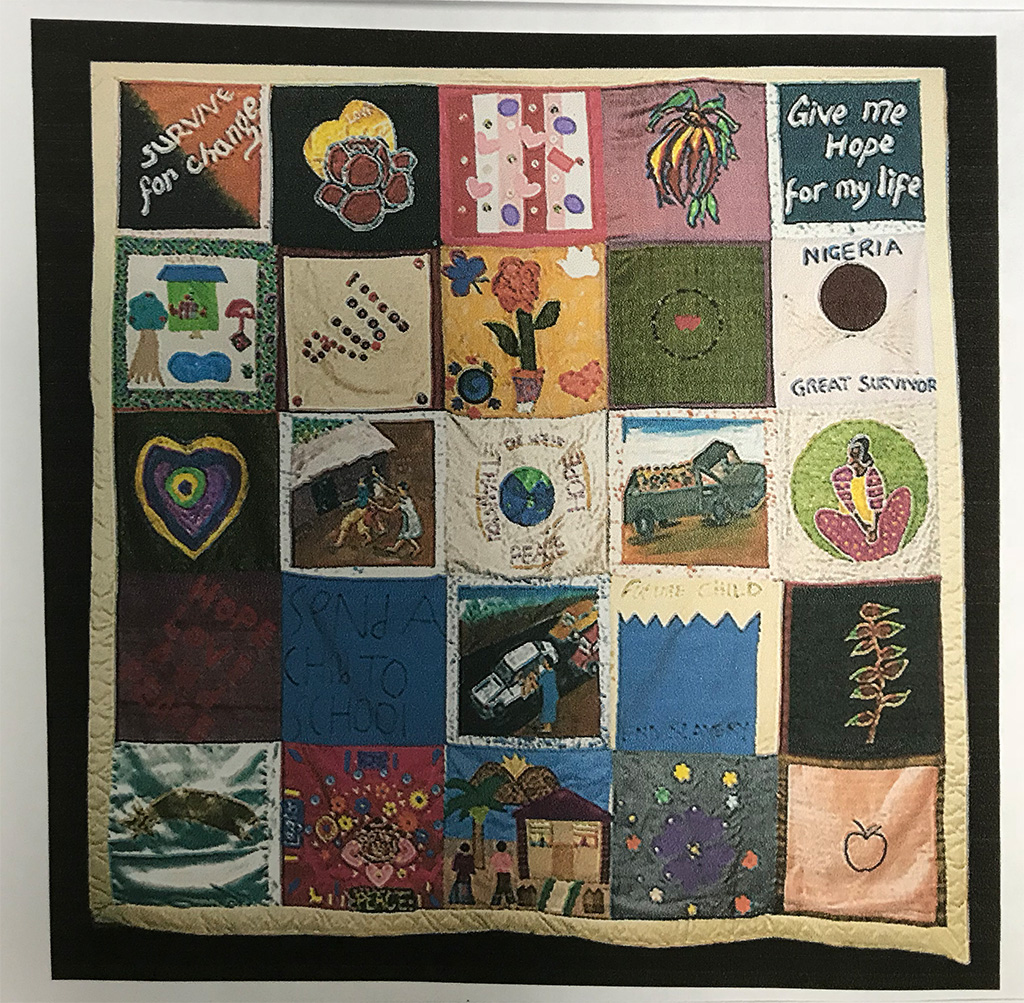
The Golden Doors to Freedom is a participatory arts project that turns abandoned doors into dramatic vehicles for communal focus on human trafficking. Guided by master gilder William Adair, trafficking survivors and allies in the community will convert discarded wooden doors into freedom portals. After applying 23k gold leaf to the doors, participants will write, stencil, draw, scratch, burnish and embellish them with their own expressions about trafficking.
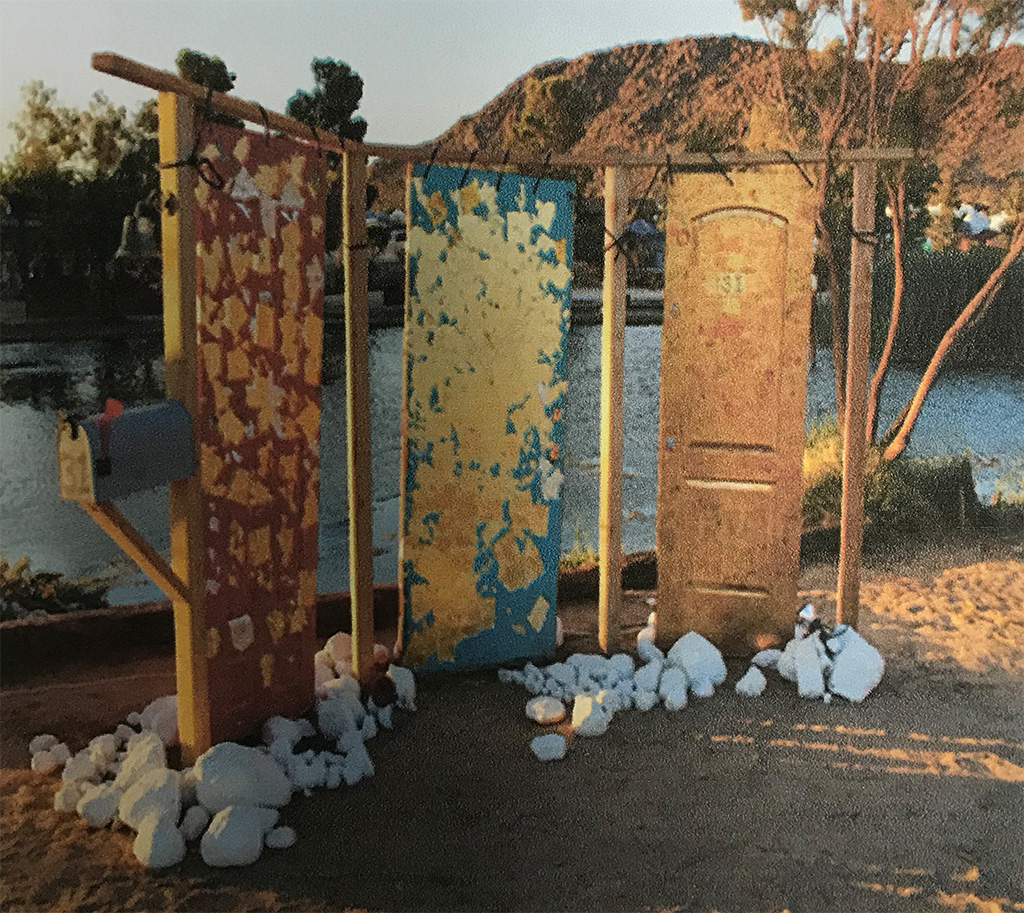
For more from Artworks for Freedom visit: https://www.artworksforfreedom.org/about-us/
RED SAND PROJECT
Molly Gochman’s Red Sand Project is an ongoing collaborative art installation created to raise awareness of modern day slavery. Participants and invited to fill sidewalk cracks with red sand or other materials, and then share an image of their transformation with the global community using the #RedSandProject.
Here is a YouTube video explaining the Red Sand Project: https://www.youtube.com/watch?v=xOCwOmHv3gA
Hidden in Plain Site
Hidden in Plain Site features creative referendums developed by a team of concerned artists in order to raise awareness of and help thwart human trafficking.
“Which one is trafficked?” is a piece created by Jerri Allyn and attempts to inform and teach the public how to spot victims of trafficking
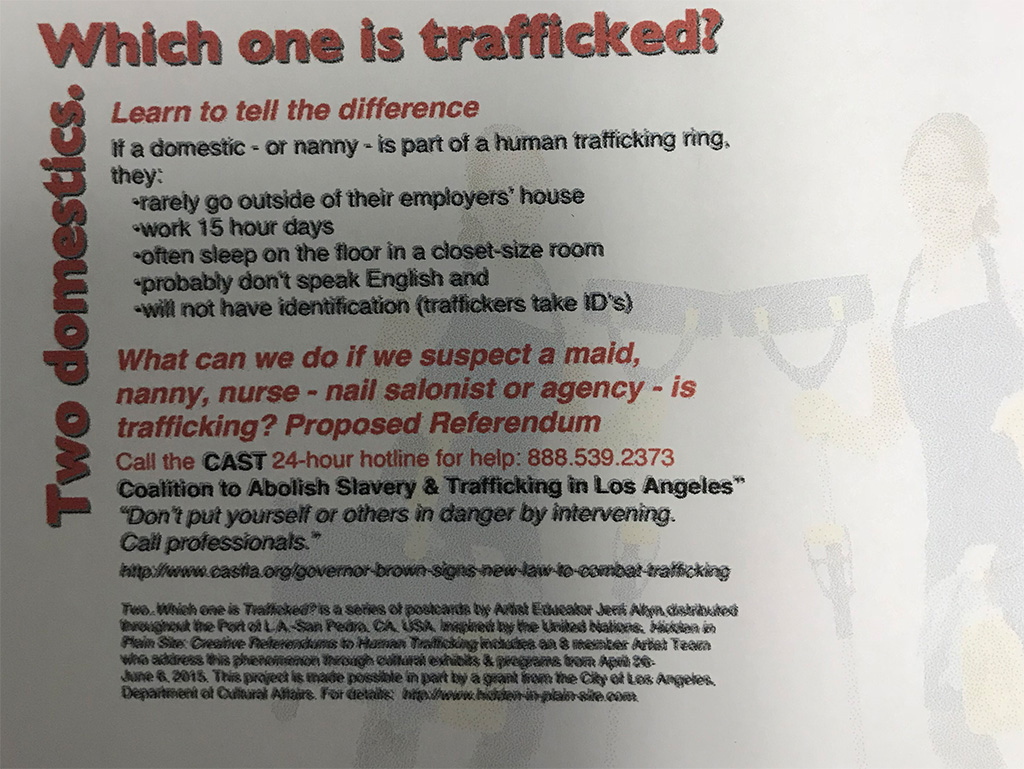
Sarafina Rodriguez’s “The Stowed Away” is an interactive play, including a short animated stop-motion film, created on an iPhone5. Rodriquez invites you to sit and imagine your own rescue scenes with these felt characters, set on flannel board. This “play” is based on true events, which Rodriquez hopes will open eyes to the mind-boggling truth of one of the world’s oldest trades – human trafficking. Through the perspective of a child playing, a dark tale of two naïve teens sold into slavery then taken to a foreign land unfolds. The play is a serious-comic-response, and the artist hopes to instill responsibility as a community, to address trafficking on a local level.
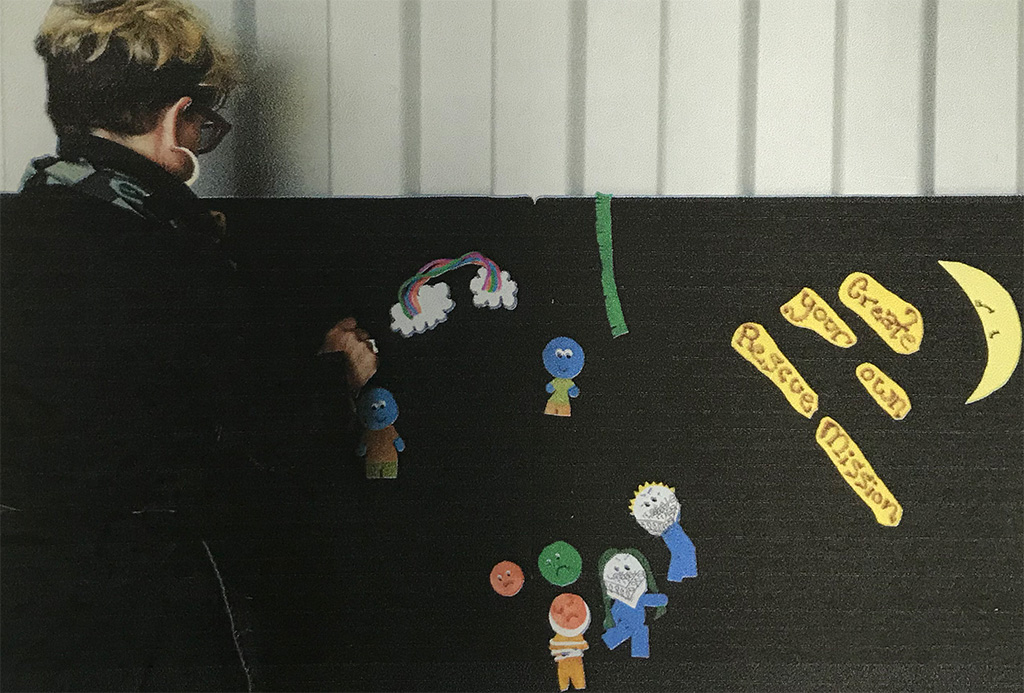
April Williams’ “Consume and Emergence” aims to challenge the character of the “cool pimp.” The character of the pimp in American media has long been viewed as a cool, suave macho man firmly in control of his stable of “grateful” girls who would be lost without him. In reality, sex trafficking in America is brutal and dehumanizing. The glorified American pimp is no better or different than a sex trafficker in Asia, Africa or Europe. The artist has been investigating and challenging the image of the glorified American pimp through a series of small and large-scale oil paintings on un-stretched canvas.
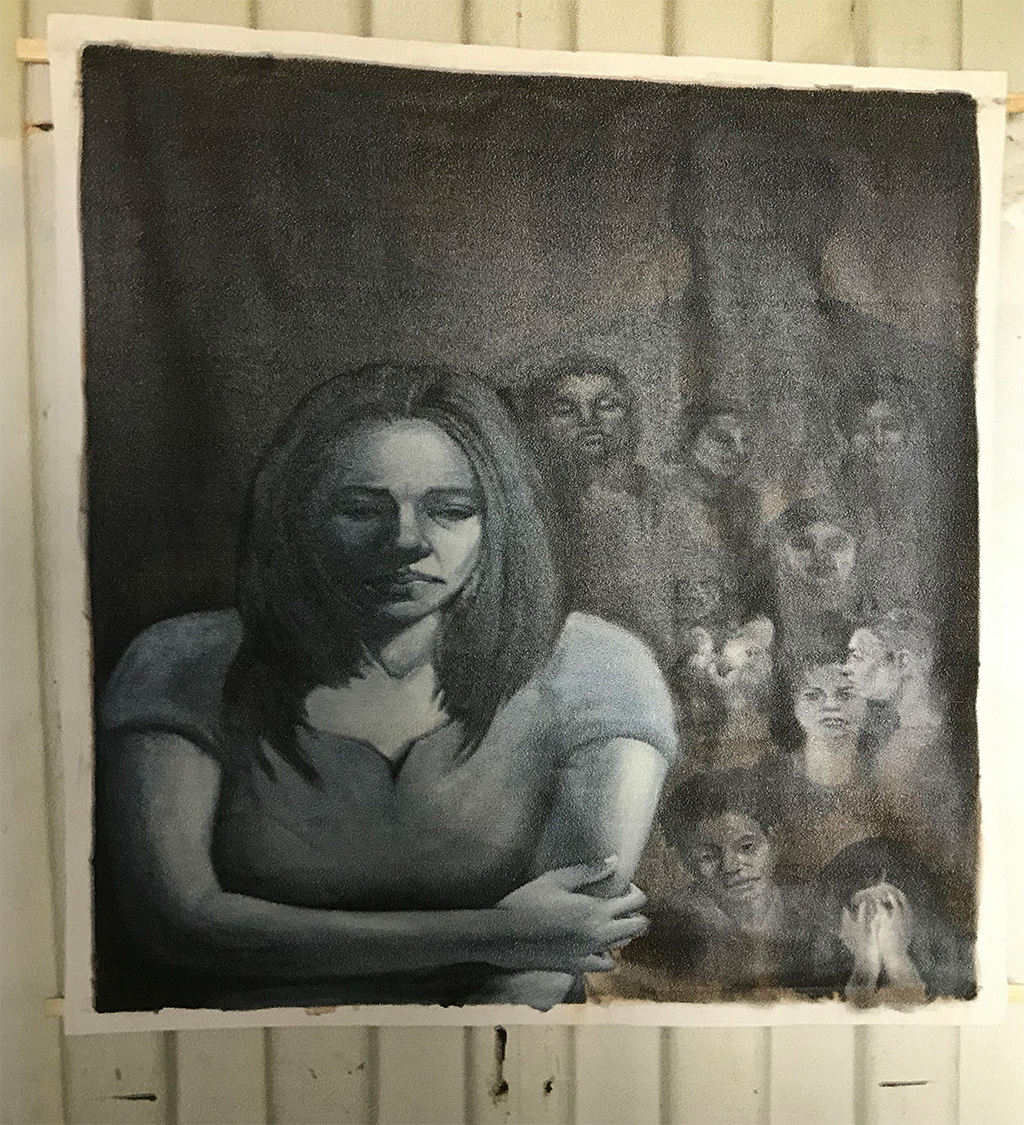
For more info and works from Hidden in Plain Site visit: http://hidden-in-plain-site.com
Survivor’s Ink
Survivor’s Ink is a nonprofit that uses a different kind of art to help trafficking victims cope. Traffickers use tattoos to mark survivors, to show “ownership.” Survivor’s Ink exists to raise awareness and to empower human trafficking victims by breaking the psychological chains of enslavement through beautifying, removing, or covering their physical scars, markings and brandings that are constant reminders of a violent past. Below are before and after photos of the tattoos of survivors.
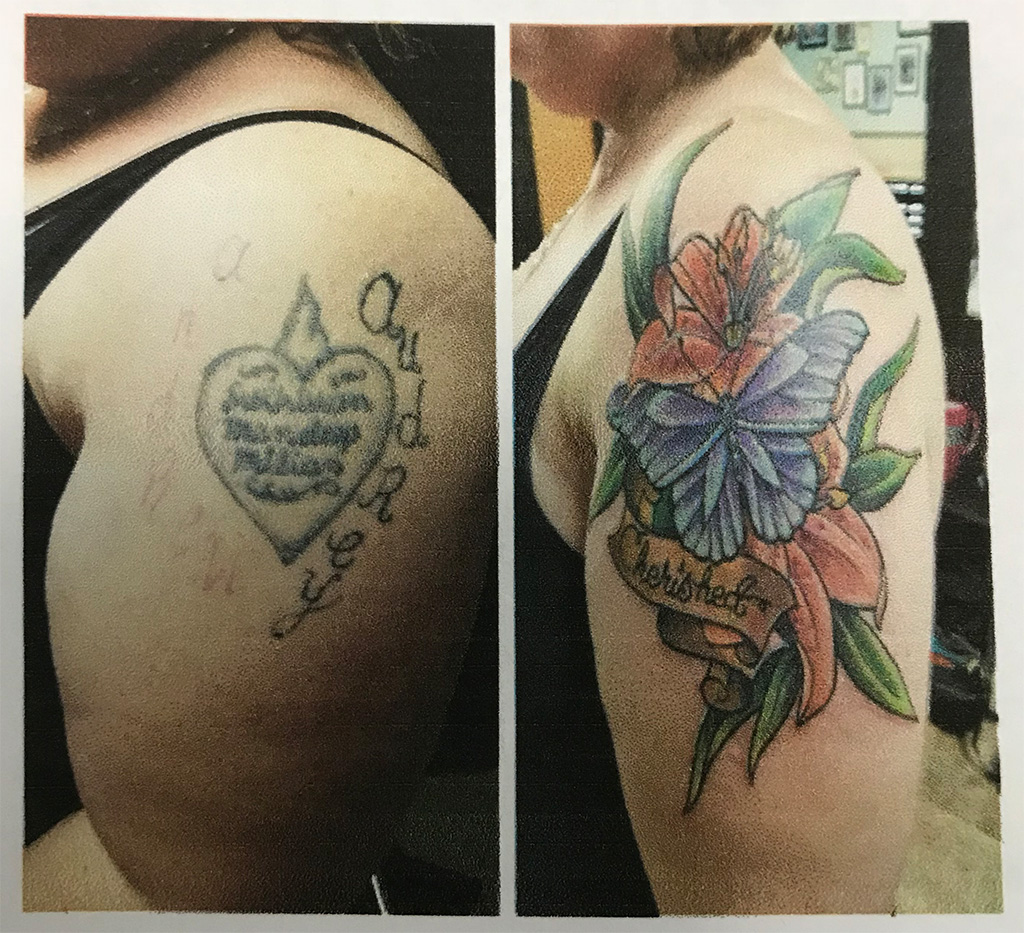
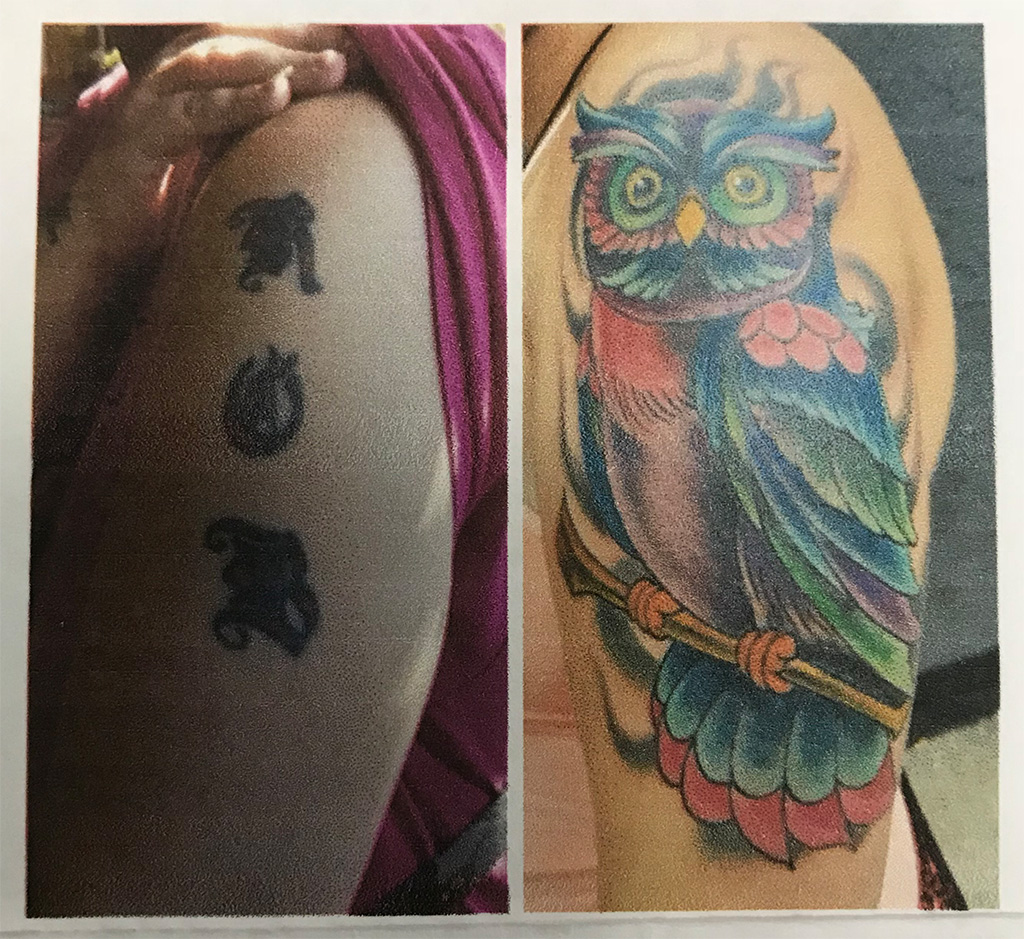
Photos by Almudena Toral for The Guardian
For more on Survivor’s Ink mission and successes visit: http://www.survivorsink.org
Wolves in the Street
A new comic launched on Snapchat and Instagram is meant to teach teens about human traffickers contacting them over social media. The first two 10-panel stories, in a series called “Wolves in the Street,” tells the story of a teenage girl who dreams of becoming a singer when she is contacted by a man on social media who promises to make her a superstar.
Dan Goldman, the artist behind the comic strip, teamed up with anti-trafficking NGO Unitas to create the story, ensuring that it is based on real-life experiences of trafficking victims.
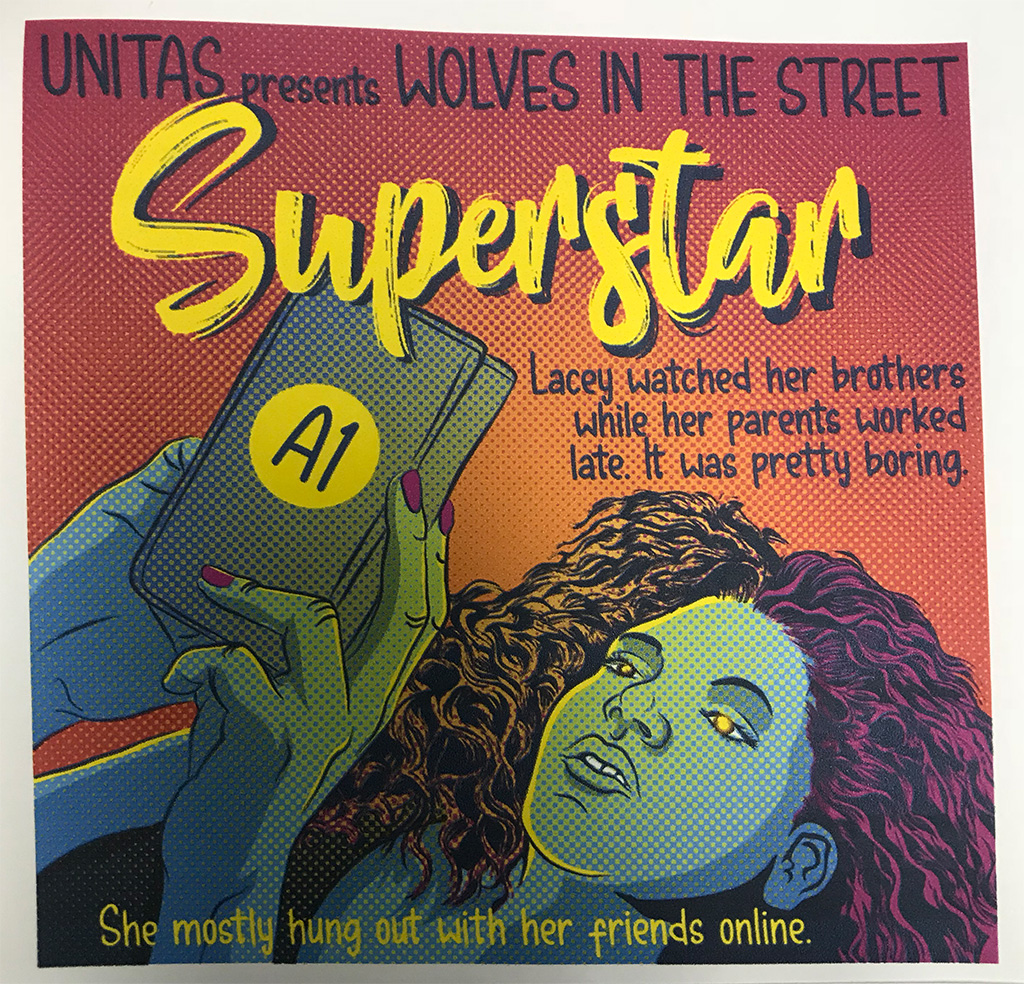
“The idea behind doing the comics this way is that we were going to go where people were looking – jump in front of their eyes,” said Goldman
Unitas is a group helps prevent human trafficking through education & awareness and helping survivors thrive.
For more info about Unitas’ mission and efforts visit: http://www.unitas.ngo
- How A Student Organization Is Helping To Combat Human TraffickingWritten by STOPP Website Staff (01/15/2019)
According to the National Human Trafficking Hotline, Ohio is ranked No. 4 in the country when it comes to reported human-trafficking cases, but Ohio State University student organization Why Us? is looking to bring awareness to this terrible issue.
Why Us? brings attention to the alarming rise in human trafficking throughout the state. The group aims to spread awareness of human trafficking on college campuses.
While it is a relatively new organization on campus, it has made early strides and hopes to make more that will leave a lasting impact at Ohio State University. “We didn’t feel like there was an organization doing so,” Ray’Chel Wilson, vice president of Why Us?, said. “Although there are many great anti-human-trafficking organizations, we just wanted to be a force of our own against human trafficking.”
In its short time as a student group, Why Us? was recognized at Mahogany Moments, Ohio State’s annual 40th Annual African American Heritage Festival, for outstanding student organization. Its main goal is to spread information on the rising threat specifically on college campuses, as well as help people prepare for human-trafficking-related situations, but the group is also open to collaborating with other student organizations. “We do try and obtain strategic partnerships. The group held a rally earlier this year,” Wilson said. “It was one of my favorite events with Why Us?”
The organization also had Barbara Freeman, founder of The Freeman Project, a nonprofit organization that provides counsel and resources to human-trafficking victims, and Elaine Richardson, professor of literacy studies, as guest speakers, both of whom are survivors of human trafficking and have worked with the AIDS Healthcare Foundation. Wilson said that when more people are aware of the problem, more cases will be recognized and reported in the state, and more laws will be passed to criminalize human-trafficking acts.
In a recent report from the Ohio Human Trafficking Task Force, more than 300 people in the state were victims of sex trafficking, about 25 were trafficked for hard labor, and another eight were trafficked for both purposes. “On the surface, it sounds bad, but the reality is, we know that human trafficking is taking place in every community in our country,” said Teresa Stafford, Senior Director of Victims Services and Outreach at the Cleveland Rape Crisis Center. “Being ranked so high means Ohio is identifying survivors of trafficking.”
Victims can come from any socioeconomic, racial, or geographic background, she says, and anyone can be a victim of trafficking. Why does Ohio have so much trafficking? There are a lot of reasons, experts say. “We have a lot of, five major highways, connected to Ohio. We also have a demand for services here in Ohio, unfortunately. We have a lot of strip clubs in communities. We have a need for, even for labor trafficking, with having a lot of farmland here in Ohio. The demand is just here for certain type of things,” said Stafford.
For more info on Ohio’s Human Trafficking Problem visit the following:
https://www.ohioattorneygeneral.gov/HumanTrafficking
For the full story on “Why Us?” check out:
- The Girl from Cameroon: Human Trafficking Survivor Describes Forced Labor Ordeal in U.S.Written by STOPP Website Staff (01/05/2019)
Evelyn Chumbow of Cameroon says she was only nine years old when she was trafficked into forced labor in the Washington, D.C. area.
Chumbow, who’s now in her mid-30s, says she was sold by her uncle to a woman from her home country of Cameroon who had a home and a business in the United States. She said she came to the United States with the expectation that a better life awaited her.
“The image that I had of the U.S. is completely from what I saw on television — you know, ‘(The) Cosby Show’ and ‘(The) Fresh Prince of Belair,’ ‘(Beverly Hills) 90210’ — and so when I was told that I was going to come to the U.S. and be adopted and get a better education, I was excited,” Chumbow said in an interview with Hill TV that aired Monday.
But she said that as soon as she arrived, she was forced into domestic labor, working for eight years before she was able to escape with the help of Catholic groups. She said her captor is now in prison.
The Republic of Cameroon is a country of some 23 million people wedged in West and Central Africa. Due to lack of policing and its neighboring countries of Nigeria and Chad, Cameroon has been a hotbed for trafficking crimes by gangs and terrorist groups.
In 2016, the Yaoundé-based Interpol office for Central African States reported that thousands of children, alongside men and women, were forcibly abducted in Cameroon, Chad, Central African Republic, Gabon, Equatorial Guinea and the Republic of Congo to be used as combatants, cooks, guards, sex partners, servants, messengers, and spies.
As many as 800,000 people are trafficked across international borders each year, according to the U.S. State Department.
Human trafficking has become a rare bipartisan issue on Capitol Hill.
Rep. Martha McSally (R-Ariz.) warned during a September 26, 2018 congressional hearing that trafficking is taking place in the U.S.
“We all need to wake up because human trafficking is happening right here in our backyard, and victims of traffic crime are often hidden in plain sight,” said McSally, who’s running for Senate in Arizona this year.
Chumbow said she was held captive in the Maryland suburbs of Washington, D.C.
“I came and I became a slave right here in Maryland, not far from the Capitol. I was working, cooking and cleaning,” Chumbow said, adding that she believes she would have been saved earlier if someone in the community had notified the authorities.
“‘If you see something, say something.’ Cause a lot of neighbors saw me; I would have probably been rescued when I was 13 or 14,” she said. “But nobody said anything.”
On January 24th at 12:30 pm, Evelyn Chumbow will be speaking in northeastern Pennsylvania. Misericordia University in Dallas, Pennsylvania is hosting Ms. Chumbow in Insalaco Hall, Rooms 218 and 219. The presentation will be approximately one hour.
For more information about this public event visit www.misericordia.edu/mlk or call the Mission Integration Office at 570-674-1877.
See the links below to a video and written pieces about Ms. Chumbow, who has become an activist fighting for the sake of modern slaves.
For Evelyn’s full story visit: https://thehill.com/hilltv/rising/410406-cameroon-woman-describes-her-forced-labor-ordealin-america
For more information on human trafficking in Cameroon visit:https://www.voanews.com/a/africa-cameroon-child-trafficking/4278961.html
- Online Gaming: The Newest Weapon of Human Traffickers: Part 3Written by STOPP Website Staff (12/20/2018)
In the first two parts of this three-part story the threat of online gaming was introduced and those it has affected were covered. Now it is time to talk about warning signs and prevention of any online gamers becoming victims of human trafficking.
Children put themselves at great risk by communicating in online gaming forums with individuals they do not know in person. This is a place where individuals can interact with microphones or through messaging, and it is a place where traffickers can get in touch with potential victims through the process of grooming.
Internetsafety101.Org, a non-profit that informs others on how children can stay safe on the Internet, warns that online grooming is a process that can take place in a short time or over an extended period of time. Initial conversations online can appear innocent, but often involve some level of deception.
As the trafficker (usually an adult) attempts to establish a relationship to gain a child’s trust, they may initially lie about their age or may never reveal an actual age to the child, even after forming an established online relationship. Often, the groomer will know popular music artists, clothing trends, sports team information, or another activity or hobby the child may be interested in, and will try to relate to the child. These tactics lead children to believe that no one else can understand them or their situation like the groomer. After the child’s trust develops, the groomer may use sexually explicit conversations to test boundaries and exploit a child’s natural curiosity about sex. Predators often use pornography and child pornography to lower a child’s inhibitions and use their adult status to influence and control a child’s behavior.
Lynne Barletta is founder of Catch the Wave of Hope, which is a nonprofit organization that has a mission to stop human trafficking. She warns that children can be trafficked from the comfort of their own home through these online gaming forums. She suggests some tips for monitoring and preventing your child from becoming a victim of traffickers:
- Help your kids by communicating
- Be emotionally available — predators often target children who crave attention.
- Set Internet and cell phone limits and rules — many victims are first approached on the Internet because the groomers can remain faceless.
- Explain what sex trafficking is in frank terms.
- Observe
- Look for new friends you’re not familiar with.
- Look for changes in your child’s dress, attitude, behavior.
- A sudden influx of money can mean they’re being groomed.
Now all of this is not designed to make all online gaming a villain. On the contrary, most online gaming interaction is friendly or mere competitive banter and teasing. In fact, some games are designed to help the public better understand the horrors of human trafficking like Missing: Game for a Cause. The game follows the story of Champa, a girl who wakes up disoriented in a locked room. She soon learns that she’s been sold to a brothel. She’s trapped, and it’s up to you to help her navigate her horrifying new situation. Leena Kejriwal, an Indian photographer and installation artist who grew up close to her city’s red light district, created the game. As a child Leena was warned of the horrors and told to avoid it, as an adult she went back and listened to the all too real stories of victims of human trafficking.
“I think what I always felt for them came alive when I went into the red light district, after so many years. So, slowly, what happened was, as an artist, the plight of those girls who had been exploited and trafficked into the red light became the forefront of all my work,” she said.
For more information on the work of Internet Safety 101 visit:https://internetsafety101.org/grooming#
For more info on Catch the Wave of New Hope check out the following: https://katu.com/news/local/expert-warns-of-summer-sex-trafficking-dangers
https://www.catchthewaveofhope.org/
For the full story on Leena Kejriwal’s game see: https://venturebeat.com/2018/05/31/the-indiebeat-using-games-to-shine-a-light-on-sex-trafficking/
- Help your kids by communicating
- Online Gaming: The Newest Weapon of Human Traffickers: Part 2Written by STOPP Website Staff (12/10/2018)
In part one of this three part story the dangers of human traffickers using online gaming forums were introduced and covered briefly with the hope of educating the public about this new and very real threat. Now it is time to talk about those who are threatened and those who have become victims of online gaming menaces.
Online multiplayer action survival and building games, like Fortnite and Minecraft, are great places to interact and play games with your friends or people all over the world. But they also pose severe risks to children and teens. The National Society for the Prevention of Cruelty to Children (NSPCC) stated that it believed these games were putting children at risk of online grooming. One report even states that a mother overheard attempts to groom her own 10-year-old son through his Xbox videogame console as he played Fortnite while sitting next to her. She heard an adult male address her son by name through her TV speakers and ask her son questions about sex.
The virtual building blocks game, Minecraft, is no different. The premise of the online mega-game franchise Minecraft is simple. Perhaps that is one of the reasons millions of children across the world are attracted to the game. But as a court in the United Kingdom has heard, the Minecraft world being created by Adam Isaac was not a virtual playground to explore imagination. His world was a trap – a trap to lure young real-life prey into conversation and to abuse. Isaac has now been jailed for two years and eight months for sexually grooming two children, persuading them to carry out sexual acts and exposing himself online. He met them through Minecraft, but the game is just one of scores of internet video multiplayer games attracting children and adults alike in the millions every day, every hour, every minute, everywhere.
A recently released film is showing the horrific story of how a 14-year-old boy was lured to his death by an older man he met online gaming. Breck Bednar was murdered by Lewis Daynes in 2014 in England. Four police forces have teamed up to produce “Breck’s Last Game,” which aims to educate and protect boys from online grooming. The short film, which will be rolled out in schools across the country, explains how the teenager played games online with friends, on a server run by his killer. Daynes, then 18, groomed Breck over 13 months before luring him to his flat where he fatally stabbed him.
If this young man was at risk for innocently playing video games and trying to make friends then so are the millions of kids who do the same. The reason police are encouraging individuals to watch Brock’s story is not to just scare them and make them horrified for the rest of the day; it is to give these kids the warning that kids like Brock never received. That warning is that there are real dangers in these virtual worlds. Criminals like predators and human traffickers love low risk meeting places like online gaming because they can remain faceless while grooming possible targets and do not have to show themselves until meeting a victim face to face.
For more information on the efforts and warnings by the NSPCC visit: https://www.nspcc.org.uk/preventing-abuse/keeping-children-safe/online-safety/online-games-helping-children-play-safe/
For more info on online gaming grooming by criminals visit: https://www.teensafe.com/blog/predators-groom-children-gaming-online/
For the full story on the Minecraft case visit: https://www.dailymail.co.uk/news/article-4140316/Adam-Isaac-22-groomed-two-young-boys-Minecraft.html
For the full story on Breck’s Last Game visit: https://leics.police.uk/news-appeals/news/2018/09/19/brecks-last-game-film-warns-of-dangers-of-online-grooming
From the Episcopal News Service: The Anglican Church of Canada is fighting human trafficking and has formed a new discernment group and developed an online human trafficking hub with information and resources. “Crucial to this process will be identifying Anglicans involved in work against human trafficking,” the statement said, as they called on those working to eradicate human trafficking to contact them. To read the entire article, go to http://episcopaldigitalnetwork.com/lens/2017/08/01/canadian-anglicans-step-up-fight-against-human-trafficking
From The Intelligencer: State Rolls Out Human Trafficking Guidelines for EMS Providers. Bruises, infections, pelvic pain, chronic back pain, difficulty breathing, panic attacks — these are just a number of the complaints EMTs and paramedics treat patients for on a regular basis. But these are also some of the symptoms that point to a possible victim of human trafficking, making those victims look a lot like many of the people EMS providers are used to helping. So how do they tell the difference? To read the entire article, go to
http://www.theintell.com?news/local/state-rolls-out-human-trafficking-guidelines-for-ems-providers/article_b159aa82-7ba9-11e7-a8eb-4bb08fdfe521.html
- Upcoming Trainings: Dates, Times, Locations of trainings and seminars on Human Trafficking or abuse.
Trainings are listed in chronological order
September 29, 2017, 8 am — 1:20 pm. The Health Care Professional’s Role When Faced with Human Trafficking. Fran and Earl Ziegler College of Nursing, the University of Oklahoma Health Sciences Center, Room 138. 1100 N. Stonewall Ave, Oklahoma City, OK. $50. Complementary for Consortium Employees. To register, contact: judy.blalock@integrisok.com
September 30, 2017, 9:00 am — 4:00 pm. School-based Sex-Trafficking Prevention. Arizona State University, Downtown Campus, Westward Ho, Concho Room. 618 N. Central Ave, Phoenix, AZ 85004. http://tinyurl.com/SchoolPrevention
October 11, 2017, 9:30 am — 3:30 pm. Hiding in Plain Sight — Unmasking Human Trafficking. Emergency Management Building, 185 Water Street, Wilkes-Barre, PA 18701. Register by October 4, 2017. $25. Complimentary for members of The PA Association on Probation, Parole, and Corrections. Contact: Claudia.fisher@luzernecounty.org
October 17, 2017, 9:30 am — 3:30 pm. Hiding in Plain Sight — Unmasking Human Trafficking. Westmoreland County Courthouse, 1st Floor. 2 N. Main St. Greensburg, PA 15601. Register by October 10. 2017. $25. Complimentary for members of the PA Association on Probation, Parlo9e, and Corrections. Contact: jhanley@pagov or dkirkbride@renewaline.com
October 20, 2017, 9:30 am — 3:30 pm. Hiding in Plain Sight — Unmasking Human Trafficking. PA Depot of Transporaiton, 7000 Gerdes Blvd, King of Prussia, PA 19406. Register by October 13, 2017. $25. Complimentary for members of The PA Association on Probation, Parole, and Corrections. Contact: camlaughl@pa.gov
October 27, 2017, 9:30 am — 3:30 pm. Hiding in Plain Sight — Unmasking Human Trafficking. PENN DOT Riverfront Office Center, 1101 S. Front Street, Harrisburg, PA 17104. $25. Complimentary for members of The PA Association on Probation, Parole, and Corrections. Contact: rsmith@pa.gov or rdreisbach@pa.gov
